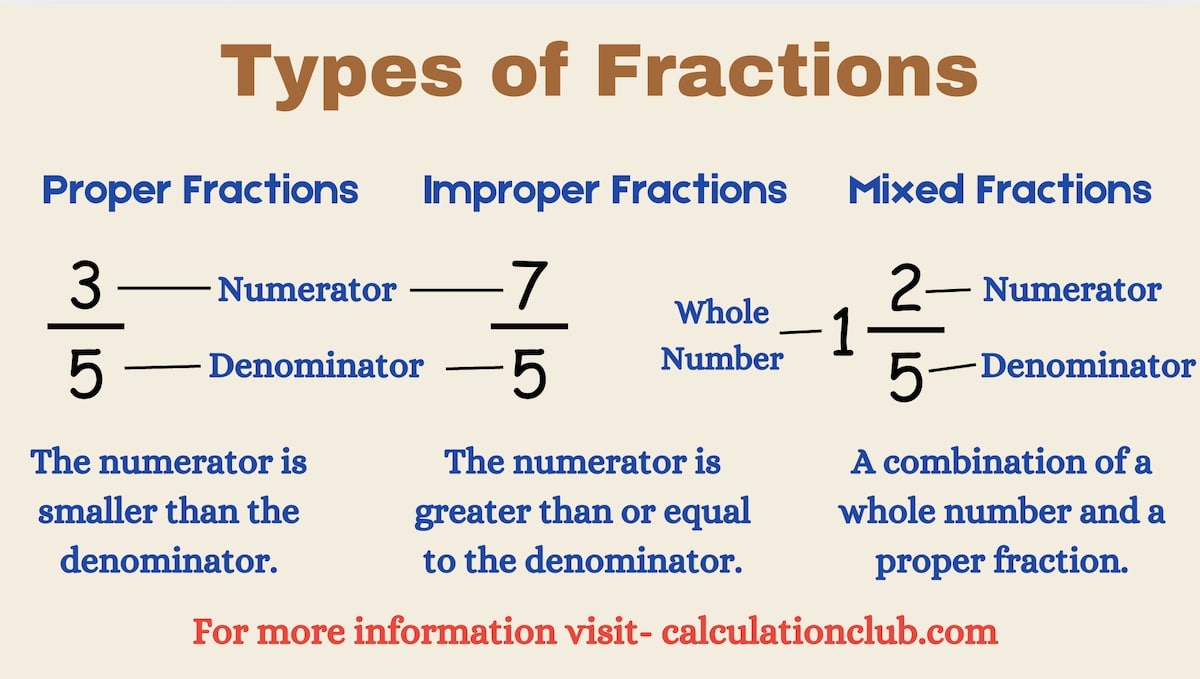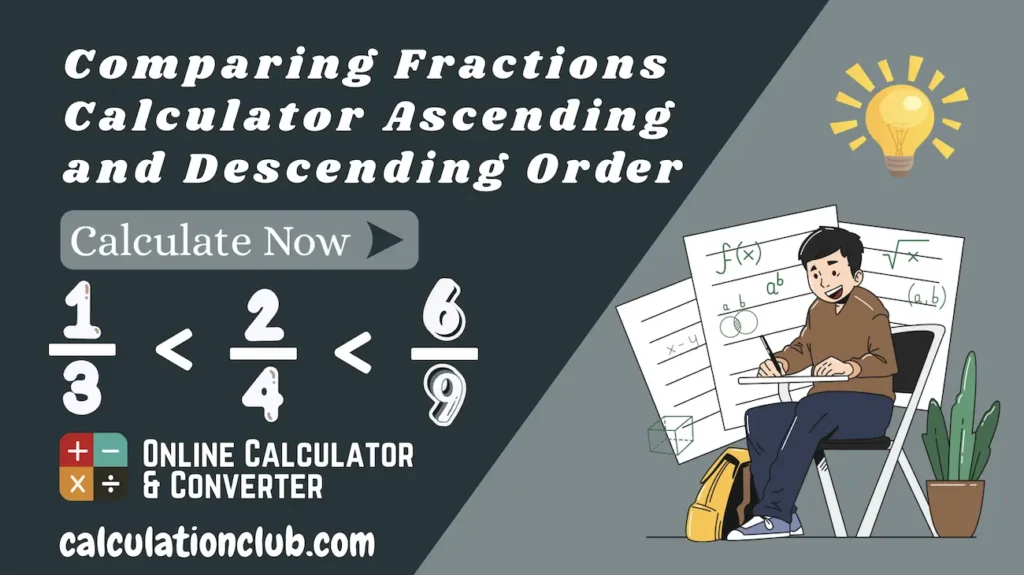Fraction Simplifier Calculator
Fraction Simplifier Calculator is an online tool designed to simplify whole numbers, mixed numbers, proper fractions, and improper fractions into their simplest form. Whether you’re working with a single fraction or a mixed fraction, this calculator instantly reduces them to the lowest terms while providing step-by-step explanations for better understanding.
While most online simplifier tools support only basic fraction inputs, CalculationClub.com offers a unique fraction simplifier that can handle complex expressions—including mixed and improper fractions—making it a versatile solution for all your fraction simplification needs.
With this tool, you can easily simplify values like 4$\frac{6}{8}$ to 4$\frac{3}{4}$ or reduce $\frac{36}{60}$ to $\frac{3}{5}$. Whether you’re a student learning fraction fundamentals or someone seeking accurate simplifications for academic or professional purposes, this calculator is fast, easy to use, and highly dependable.
How to Use the Online Fraction Simplifier Calculator?
1. Entering Fractions: Input whole numbers (optional), numerators, and denominators using the input fields. You cannot enter decimal values—only whole numbers are allowed. Ensure that numerator and denominator fields are not empty or zero.
2. Simplifying Fractions: Once all values are entered, click the “Simplify” button. The calculator will instantly reduce all fractions to their simplest form and display:
- The simplified proper or improper fraction
- The equivalent mixed number (if applicable)
- The decimal representation (for reference)
3. Hiding Steps: Use the “Hide Steps” button to collapse the step-by-step simplification process.
4. Resetting the Calculator: Click the “Reset” button to clear all inputs and start a fresh simplification.
This tool ensures accurate fraction operations with a user-friendly interface, making it ideal for students, professionals, and anyone working with fractions.

Understanding Fractions ?
A fraction is a way to show parts of a whole. It has two numbers: the top number, called the numerator, and the bottom number, called the denominator. The numerator tells how many parts you have, while the denominator shows how many equal parts the whole is divided into.
For example, in the fraction $\frac{3}{4}$, the numerator (3) means you have three parts, and the denominator (4) means the whole is split into four equal pieces. So, $\frac{3}{4}$ represents “three out of four parts.”
In a fraction, there are three key components:
- Numerator – The top number in a fraction. It represents how many parts of a whole are taken.
- Denominator – The bottom number in a fraction. It represents the total number of equal parts the whole is divided into.
- Whole Number – In a mixed fraction, the whole number is the integer part that stands separately from the fraction.
Types of Fractions:
1. Proper Fractions – The numerator is smaller than the denominator.
- Example: $\frac{3}{4}$ → (3 is the numerator, 4 is the denominator).
- Condition: Numerator < Denominator
- Meaning: Represents a value less than 1.
2. Improper Fractions – The numerator is greater than or equal to the denominator.
- Example: $\frac{5}{3}$ → (5 is the numerator, 3 is the denominator).
- Condition: Numerator ≥ Denominator.
- Meaning: Represents a value greater than or equal to 1.
3. Mixed Fractions – A combination of a whole number and a proper fraction.
- Example: 2$\frac{1}{3}$ → (2 is the whole number, 1 is the numerator, and 3 is the denominator).
- Meaning: Represents a value greater than 1 but written in a form that separates the whole part from the fraction.
Fractions are part of everyday life—you see them when splitting food, measuring ingredients, or dividing time. You can also convert fractions to decimals to make calculations or comparisons easier.

Why Can’t the Numerator or Denominator Be Zero?
When working with fractions, it is important to understand the restrictions on numerators and denominators:
- Numerator must be nonzero (except for zero fractions): A fraction with a zero numerator (e.g., $\frac{0}{4}$) always results in zero, regardless of the denominator. While such fractions are valid, they are often unnecessary in calculations.
- Denominator cannot be zero: A fraction with a denominator of zero (e.g., $\frac{3}{0}$) is undefined in mathematics because division by zero is impossible. Since division is the process of splitting into equal parts, having zero parts to divide by makes no logical sense.
In short, while a numerator of zero makes the entire fraction zero, a denominator of zero makes the fraction undefined, which is why it is not allowed.
Formulas for Simplifying Fractions
1. Mixed to Improper Fraction Formula
Improper Fraction = $\frac{(\text{Whole Number} \times \text{Denominator}) + \text{Numerator}}{\text{Denominator}} $
2. Simplifying Fractions Formula
$ \frac{a}{b} = \frac{a \div \gcd(a, b)}{b \div \gcd(a, b)} $
Where GCD = Greatest Common Divisor of numerator and denominator.
3. Improper Fraction to Mixed Number Formula
$ \text{Mixed Number} = \text{Quotient} \ \frac{\text{Remainder}}{\text{Denominator}} $
Where:
- Quotient = Integer part of division
- Remainder = What’s left over
Example 1: Mixed to Simplest Mixed Input: $2\frac{4}{6}$
Step 1: Convert to improper: $ (2 \times 6) + 4 = 12 + 4 = 16 \Rightarrow \frac{16}{6} $
Step 2: Simplify: $ \gcd(16,6) = 2, \quad \frac{16}{6} = \frac{8}{3} $
Step 3: Convert to mixed: $ 8 \div 3 = 2 \text{ R } 2 \Rightarrow 2\frac{2}{3} $
Example 2: Mixed to Simplest Mixed Input: $3\frac{9}{12}$
Convert to improper: $ (3 \times 12) + 9 = 36 + 9 = 45 \Rightarrow \frac{45}{12} $
Simplify: $ \gcd(45,12) = 3, \quad \frac{45}{12} = \frac{15}{4} = 3\frac{3}{4} $
Example 3: Improper to Simplest Mixed Input: $\frac{36}{8}$
Simplify: $ \gcd(36,8) = 4, \quad \frac{36}{8} = \frac{9}{2} $
Convert to mixed: $ 9 \div 2 = 4 \text{ R } 1 \Rightarrow 4\frac{1}{2} $
Example 4: Proper Fraction to Simplest Input: $\frac{18}{24}$
Simplify: $ \gcd(18,24) = 6$,
$\quad \frac{18}{24}$ = $\frac{3}{4} $
Example 5: Mixed with Larger Numbers Input: $5\frac{15}{20}$
Convert to improper: $ (5 \times 20) + 15$ = 100 + 15 = $\frac{115}{20} $
Simplify: $ \gcd(115,20) = 5$
$\frac{115}{20}$ = $\frac{23}{4}$ = $5\frac{3}{4} $
Note: You can easily calculate the simplest form of a fraction with our Online Fraction Simplifier Calculator.
FAQs on Fraction Simplifier Calculator
1. What is a Fraction Simplifier Calculator with Whole Numbers?
A Fraction Simplifier Calculator with whole numbers helps reduce fractions that include whole numbers—such as mixed fractions—into their simplest form. It separates and simplifies the fractional part while retaining the whole number.
2. How does a Simple Fraction Simplifier Calculator work?
A simple fraction simplifier calculator reduces proper and improper fractions by dividing both the numerator and the denominator by their greatest common divisor (GCD). For example, $\frac{12}{16}$ becomes $\frac{3}{4}$.
3. What does a Mixed Fraction Calculator do?
A Mixed Fraction Calculator performs arithmetic operations like addition, subtraction, multiplication, and division on mixed numbers. It also converts between mixed and improper fractions.
4. How to use a Simplify Mixed Fractions Calculator?
To simplify mixed fractions, the calculator first converts the mixed number into an improper fraction, then simplifies it to its lowest terms. For example, $1\frac{2}{4}$ becomes $\frac{6}{4}$, which simplifies to $1\frac{1}{2}$.
5. What is a Simplify Calculator?
A Simplify Calculator refers to any tool that reduces numbers or expressions to their simplest or most basic form. For fractions, it ensures the numerator and denominator have no common factors other than 1.
6. What is an Improper Fraction Calculator?
An Improper Fraction Calculator converts mixed numbers into improper fractions and performs arithmetic operations or simplification. For instance, $2\frac{3}{5}$ becomes $\frac{13}{5}$.
7. Can a Fraction Simplifier Calculator convert a fraction to a decimal?
Yes. Many fraction simplifier calculators also include a fraction-to-decimal converter. For example, $\frac{3}{8} = 0.375$.
8. How do you convert a Mixed Number to an Improper Fraction?
To convert a mixed number to an improper fraction, use this formula:
$\text{Whole Number} \ \frac{\text{Numerator}}{\text{Denominator}} $
$\Rightarrow\frac{(\text{Whole Number} \times \text{Denominator}) + \text{Numerator}}{\text{Denominator}} $
Then write it over the original denominator. Example: $2\frac{1}{3}$ = $\frac{(2 \times 3) + 1}{3}$ = $\frac{7}{3}$
Conclusion: Our Fraction Simplifier Calculator streamlines the process of reducing fractions to their simplest form with accuracy and clarity. It offers a step-by-step breakdown to simplify proper fractions, improper fractions, and mixed numbers, making it easy to understand how simplification works. With this tool, you can quickly reduce fractions, visualize detailed solution steps, and get precise results in just seconds. Mastering fraction simplification improves your mathematical skills, supports practical problem-solving, and enhances your confidence in handling both academic and real-world calculations.
My Request to All: If you enjoy using my Fraction Simplifier Calculator and my website, please consider sharing the link to this page or the website with your friends. Additionally, if you have any requests, complaints, suggestions, or feedback, feel free to reach out via our WhatsApp channel or Telegram group.
Telegram Link– Click Here
Youtube Link– Click Here
For more tools, please visit our homepage at Calculationclub.com.
For additional tools in Hindi, you can visit Meter to Feet
Thank you for your support!


